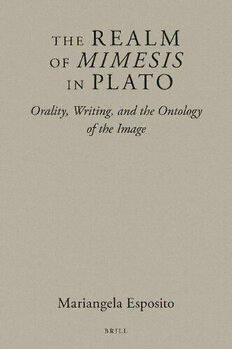
The Realm of Mimesis in Plato: Orality, Writing, and the Ontology of the Image PDF
Preview The Realm of Mimesis in Plato: Orality, Writing, and the Ontology of the Image
The Realm of Mimesis in Plato Brill’s Plato Studies Series Editors Gabriele Cornelli (Brasilia, Brazil) Gábor Betegh (Cambridge, United Kingdom) Editorial Board Beatriz Bossi (Madrid, Spain) Luc Brisson (Paris, France) Michael Erler (Würzburg, Germany) Franco Ferrari (Salerno, Italy) Maria do Ceu Fialho (Coimbra, Portugal) Mary-Louise Gill (Providence, USA) Debra Nails (Michigan, USA) Noburu Notomi (Tokyo, Japan) Olivier Renaut (Paris, France) Voula Tsouna (Santa Barbara, USA) volume 13 The titles published in this series are listed at brill.com/bpss The Realm of Mimesis in Plato Orality, Writing, and the Ontology of the Image By Mariangela Esposito leiden | boston The Library of Congress Cataloging-in-Publication Data is available online at https://catalog.loc.gov Typeface for the Latin, Greek, and Cyrillic scripts: “Brill”. See and download: brill.com/brill-typeface. issn 2452-2945 isbn 978-90-04-53311-0 (hardback) isbn 978-90-04-53454-4 (e-book) Copyright 2023 by Mariangela Esposito. Published by Koninklijke Brill NV, Leiden, The Netherlands. Koninklijke Brill NV incorporates the imprints Brill, Brill Nijhoff, Brill Hotei, Brill Schöningh, Brill Fink, Brill mentis, Vandenhoeck & Ruprecht, Böhlau, V&R unipress and Wageningen Academic. Koninklijke Brill NV reserves the right to protect this publication against unauthorized use. Requests for re-use and/or translations must be addressed to Koninklijke Brill NV via brill.com or copyright.com. This book is printed on acid-free paper and produced in a sustainable manner. This tablet shouts aloud terrible, dreadful words. Where can I run to, where can I escape this crushing weight, this pain? I’m dead. I am destroyed. This song, the writing’s voice is venom to my eyes. Euripides, Hippolytus (vv. 971–977) ∵ Contents Abstract ix Acknowledgements x Premises xi Introduction 1 1 The Critique of Writing in Plato’s Works 5 1 “I Have Discovered a Potion for Memory and for Wisdom” 6 2 “If the Author Is Really Serious, This Book Does not Contain His Best Thoughts” 18 3 “If a Man Has Nothing More Valuable Than What He Has Composed or Written” 31 4 “Nothing More Valuable” 39 5 “He Will Sow Gardens of Letters for the Sake of Amusing Himself” 47 2 The Critique of Orality in Plato’s Works 49 1 Orality and Vocality 50 2 Myth and Philosophy 64 3 The Arts and the City 70 4 Hermeneia and Responsibility 80 5 Image-Making 87 3 The Ontology of the Image in Plato’s Works 94 1 Eidos and Eidolon 95 2 The Ontology of the Pseudos 101 3 Mirrors and Paidia 108 4 Shadows and Dialectic 117 5 Beauty and Wonderment 128 Conclusion 137 Afterword 143 Bibliography 148 General Index 159 Index Locorum 170 Abstract Plato lived at the cusp of an anthropological paradigm shift, very similar to the one we have been experiencing for a few decades. As we experience the progressive erosion of literacy in favour of digitalisation, Plato’s dialogues wit- ness the transition from orality to literacy, both with their contents and with their literary style. Located in the blind spot of this transition, the dialogues are living contradictions: they are written dialogues, partly literary, partly oral; this contradiction informs also one of the most vexed issues of the history of Platonic interpretation, the relationship between orality and writing in the dialogues. This monograph is a contemporary philosophical inquiry into the complex issue of the relationship between Plato’s respective criticisms of orality and writing. The main aim of this study is to argue that this relationship, often read as a straightforward opposition, is instead grounded in a more ontologi- cal level of analysis, as is exemplified by the ontology of the image which ap- pears throughout the entire Platonic canon. An analysis of the structure of this ontology will show that both Plato’s criticism of orality and the criticism of writing are inessential, and in fact have more points of convergence than diver- gence. The theme of mimesis is the central thread of this work, which I treat as the “mechanism” that progressively reveals the continuity and co-dependency of the orality/writing opposition and the ontology of the image (itself based on the co-dependency between eidos and eidolon). The work offers an open-ended conclusion that suggests the possibility of further inquiry into the Platonic conception of beauty: the various occurrences of beauty in Plato’s works demonstrate a singular relationship between eidos and eidolon which overcomes the mimetic mechanism and points to an erotic conception of life and philosophy. The afterword, which closes the work, aims to show the relevance of this study to a broader understanding of some of the contemporary phenomena which challenge our ways of analysing, communicating, and elaborating on the visual world into which we have anthropologically shifted. Acknowledgements I would like to thank Prof Michael Breen and Dr Catherine Kavanagh who pro- vided me with the conditions to complete the research for this work, and who gave me a great amount of creative freedom and professional trust. I would like to thank Prof Daniele Guastini, mostly for our interpretative disagreements on Plato’s ontology which partially informed the last chapter of this work. I also owe a debt of gratitude to his guidance during the time spent in Rome, at La Sapienza University, under his co-supervision. I would like to thank Dr Cyril McDonnell, Dr Alessandro Stavru and Dr Eugene O’Brien for their intellectual generosity and genuine interest in this work. I would like to thank Prof Gianluca Garelli for our uninterrupted philosoph- ical dialogue over the last fifteen years. Lastly, I would like to thank Dr Susanna Mati and Dr Omar Abu Dbei for their critical and supportive observations on the nature and destiny of this work, but mostly, for their friendship.
